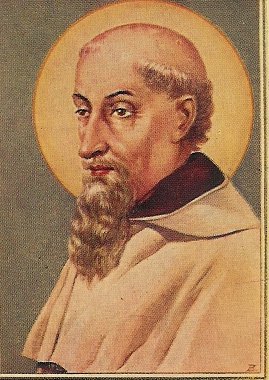Sunday, November 6, 2011
Memorial of St Nuño of St Mary (Alvares Pereira)
"Nuno was born at Sernache do Bomjardim (Portugal) on June 24, son of the noble, Don Alvaro Gonçalves Pereira, grand prior of the priory of Crato, of the Order of the Knights of St. John of Jerusalem. Nuno grew up in the company of the knights dependent on his father and was given to the reading of the knightly and military deeds of the Round Table. At the age of thirteen he was admitted to the court of King Ferdinand, in view of a military career. He soon gave such proofs of bravery that while still thirteen years old he was chosen as an equerry of the queen and created a knight. In imitation of Galahad, the pure knight of the Holy Grail, he would have wished to remain celibate; but, so as not to oppose his father, on Aug. 15, 1376, he consented to take Lady Eleonora de Alvim as his wife. He had three children, two of whom died young; the third, Beatrice, in 1401 married Don Alphonse, a son of King John I. Don Alphonse was also Count of Barcelos and the first Duke of Braganza, the founder of several princely and royal dynasties of Europe.
During the war between Portugal and Castile Nuno had many occasions to show his valor, which, however, was fully revealed only in the political crisis that followed the death of King Ferdinand (Oct. 22, 1383). Among the supporters of the right of Beatrice to the throne of Portugal—she was the daughter of the deceased King Ferdinand and the wife of the King of Castile—were not a few Portuguese, among them Nuno's own brothers. Nuno, however, tenaciously opposed the incorporation of Portugal into the kingdom of Castile and, in order to safeguard national independence, defended the candidacy of John, Master of Aviz, a brother of King Ferdinand; at the same time Nuno endeavored to overcome the hesitations and opposition of his compatriots. On April 6, 1384, he overcame the followers of the King of Castile in the battle of Atoleiros. A year later the Master of Aviz was proclaimed king of Portugal, and he chose Nuno as his Constable. Thus, at only twenty-five years of age, Nuno became the supreme commander of the army. On Aug. 14, 1385, he engaged in the battle of Aljubarrota and the definitive defeat of the Castilians, despite the fact that the Portuguese were greatly outnumbered. Nuno then passed to the offensive and gained another glorious victory in Castilian territory at Valverde (Oct. 1385). Atoleiros, Aljubarrota and Valverde were but the more salient points on a chain of guerilla encounters drawn out for several years.
To his military valor Nuno joined a profound Christian piety. He nourished special devotion to the Most Blessed Sacrament and to the Virgin Mary; he assisted at two Masses every day, and three on Saturdays and Sundays. He went often to confession, and to Communion on Christmas, Easter, Pentecost and the feast of the Assumption. In honor of Our Lady he fasted on every Wednesday, Friday and Saturday, as well as on the vigils of her feasts, even when they were days of battle. On his banner were depicted the sacred images of the Crucifixion, Our Lady, and the two patrons Of knighthood, St. James and St. George. Before battle he prepared his soldiers spiritually, exhorting them to trust in God and having them receive the sacraments. He attributed his stupendous victories to the help of God through the intercession of Our Lady. At Valverde, in the thick of the battle, when victory seemed unattainable, Nuno was found on his knees between two rocks, with hands raised up in the act of prayer.
He manifested his gratitude to Our Lady by making frequent pilgrimages to Marian sanctuaries and building churches in her honor. Thus, at Nuno's expense, the churches of Vila Viçosa, Souzel, Portel, Monsaraz, Mou-rao, fivora, Camarate were erected. All of them were dedicated to the Virgin Mary, as was the magnificent temple of Carmel in Lisbon, later destroyed by the earthquake of 1755. He also built a chapel to the Virgin Mary and to St. George exactly where his banner had stood during the battle of Aljubarrota. At Estremoz he completed the construction of a temple of Our Lady of the Martyrs, begun by King Ferdinand. Finally, bound up with the name of Nuno are the monastery and church of St. Mary of Victory, a masterpiece of Gothic architecture in Portugal and better know by the name of Batalha, ordered built by Don John I to commemorate the victory of Aljubarrota and to fulfill a vow made on the field of battle. After the death of his wife in 1387, Nuno constantly refused to enter into a second marriage. Military engagements had made him live far from home ever since 1383; yet, according to the testimony of Portuguese historians, he always gave the example of an unsullied life and never tolerated any licentiousness among his soldiers. He was always very generous in assisting the needy of every kind. When definite peace had been reestablished with Castile, Nuno distributed a great part of his immense possessions to his comrades in arms. In 1415 he took part in the Portuguese expedition to Ceuta; and then on Aug. 15, 1423, to the wonder and surprise of the whole country, Nuno abandoned all his remaining possessions and was clothed in the Carmelite habit in the convent of Lisbon, which had also been established and endowed by him. He chose the status of the so-called Oblates and dedicated himself to the most humble tasks of the convent.
He took the name Brother Nuno of St. Mary. Only the intervention of the prince, Don Edward, son of King John I, was able to prevent him from actualizing his desire to betake himself to another convent far from Portugal, so that he could avoid the frequent visits of illustrious citizens. He also expressed the desire of begging publicly for his daily food, but his superiors and the same prince Edward did not allow him this. He died in 1431 /the same year as St. Joan of Arc/, probably on April 1, after eight years of a life completely dedicated to prayer and penance. His funeral was a most solemn celebration, with the participation of the entire royal court. He was buried in the Carmelite church of Lisbon."
-- Biography by Elias Cardoso, OCarm
During the war between Portugal and Castile Nuno had many occasions to show his valor, which, however, was fully revealed only in the political crisis that followed the death of King Ferdinand (Oct. 22, 1383). Among the supporters of the right of Beatrice to the throne of Portugal—she was the daughter of the deceased King Ferdinand and the wife of the King of Castile—were not a few Portuguese, among them Nuno's own brothers. Nuno, however, tenaciously opposed the incorporation of Portugal into the kingdom of Castile and, in order to safeguard national independence, defended the candidacy of John, Master of Aviz, a brother of King Ferdinand; at the same time Nuno endeavored to overcome the hesitations and opposition of his compatriots. On April 6, 1384, he overcame the followers of the King of Castile in the battle of Atoleiros. A year later the Master of Aviz was proclaimed king of Portugal, and he chose Nuno as his Constable. Thus, at only twenty-five years of age, Nuno became the supreme commander of the army. On Aug. 14, 1385, he engaged in the battle of Aljubarrota and the definitive defeat of the Castilians, despite the fact that the Portuguese were greatly outnumbered. Nuno then passed to the offensive and gained another glorious victory in Castilian territory at Valverde (Oct. 1385). Atoleiros, Aljubarrota and Valverde were but the more salient points on a chain of guerilla encounters drawn out for several years.
To his military valor Nuno joined a profound Christian piety. He nourished special devotion to the Most Blessed Sacrament and to the Virgin Mary; he assisted at two Masses every day, and three on Saturdays and Sundays. He went often to confession, and to Communion on Christmas, Easter, Pentecost and the feast of the Assumption. In honor of Our Lady he fasted on every Wednesday, Friday and Saturday, as well as on the vigils of her feasts, even when they were days of battle. On his banner were depicted the sacred images of the Crucifixion, Our Lady, and the two patrons Of knighthood, St. James and St. George. Before battle he prepared his soldiers spiritually, exhorting them to trust in God and having them receive the sacraments. He attributed his stupendous victories to the help of God through the intercession of Our Lady. At Valverde, in the thick of the battle, when victory seemed unattainable, Nuno was found on his knees between two rocks, with hands raised up in the act of prayer.
He manifested his gratitude to Our Lady by making frequent pilgrimages to Marian sanctuaries and building churches in her honor. Thus, at Nuno's expense, the churches of Vila Viçosa, Souzel, Portel, Monsaraz, Mou-rao, fivora, Camarate were erected. All of them were dedicated to the Virgin Mary, as was the magnificent temple of Carmel in Lisbon, later destroyed by the earthquake of 1755. He also built a chapel to the Virgin Mary and to St. George exactly where his banner had stood during the battle of Aljubarrota. At Estremoz he completed the construction of a temple of Our Lady of the Martyrs, begun by King Ferdinand. Finally, bound up with the name of Nuno are the monastery and church of St. Mary of Victory, a masterpiece of Gothic architecture in Portugal and better know by the name of Batalha, ordered built by Don John I to commemorate the victory of Aljubarrota and to fulfill a vow made on the field of battle. After the death of his wife in 1387, Nuno constantly refused to enter into a second marriage. Military engagements had made him live far from home ever since 1383; yet, according to the testimony of Portuguese historians, he always gave the example of an unsullied life and never tolerated any licentiousness among his soldiers. He was always very generous in assisting the needy of every kind. When definite peace had been reestablished with Castile, Nuno distributed a great part of his immense possessions to his comrades in arms. In 1415 he took part in the Portuguese expedition to Ceuta; and then on Aug. 15, 1423, to the wonder and surprise of the whole country, Nuno abandoned all his remaining possessions and was clothed in the Carmelite habit in the convent of Lisbon, which had also been established and endowed by him. He chose the status of the so-called Oblates and dedicated himself to the most humble tasks of the convent.
He took the name Brother Nuno of St. Mary. Only the intervention of the prince, Don Edward, son of King John I, was able to prevent him from actualizing his desire to betake himself to another convent far from Portugal, so that he could avoid the frequent visits of illustrious citizens. He also expressed the desire of begging publicly for his daily food, but his superiors and the same prince Edward did not allow him this. He died in 1431 /the same year as St. Joan of Arc/, probably on April 1, after eight years of a life completely dedicated to prayer and penance. His funeral was a most solemn celebration, with the participation of the entire royal court. He was buried in the Carmelite church of Lisbon."
-- Biography by Elias Cardoso, OCarm
Subscribe to:
Post Comments (Atom)














No comments:
Post a Comment